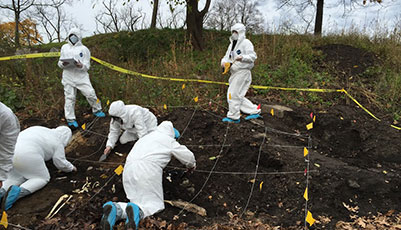
While most John Jay students were hitting the textbooks in classrooms, study halls or the library, 10 members of a graduate class in forensic anthropology were out in Central Park in mid-November, excavating, collecting and examining skeletal remains.
Professor Angelique Corthals of the Department of Sciences set up a crime scene in the composting area of the park near the 102nd street entrance after receiving a permit from the Central Park Conservancy to perform the exercise. “The permit process took a few months. I wanted to make sure we could perform it without damaging any of the landscaping of Central Park,” said Corthals. “The composting facility was a perfect place to organize this, as it is not landscaped and it’s vast enough to hide a body.”
Corthals said she went to Central Park early one morning with a skeleton and pieces of evidence, which she buried with the help of her spouse, Liliana Davalos, a professor of evolutionary biology at Stony Brook University, where Corthals also teaches. “We chose the spot because it would challenge students to find the remains, yet not take the whole day to find them,” said Corthals.
The bones are part of the Science Department’s anatomical collection, and were acquired by Corthals for use in her FOS 761 class. “They are real, and show traces of various post-mortem trauma or damage, but they have been prepared for anatomical purposes,” she explained. “So, in a way, they are not fully real, as bones from a real decomposed body would not be so pitted, porous or light. Anatomical bones are heavily blanched in hydrogen peroxide, which makes them really porous and light, and takes the reality out of them.”
The students were on-site under Corthals’ supervision from 10 AM to 3 PM. Ordinarily, Corthals noted, “real events like this exercise would take days, sometimes weeks to finish.”
Erika Klafehn, a senior majoring in Cell and Molecular Biology, said the on-site team comprised mappers, evidence collectors and diggers. “We were all in full uniform, wearing white bunny suits, booties, goggles and surgical masks,” she said. “The dig took about four hours to complete. We had to document all the bones individually, carefully measuring orientations from different landmarks and our 10x10-foot grids.”
The overall experience, she said, “was absolutely incredible. It was very tedious, but I have a lot of patience.”
Students will be examining the bones in the forensic anthropology lab, classifying and measuring each bone and trying to identify the sex, age and race of the skeletal remains. “We will have to complete an osteological report as a class, and each of us has to work together by bringing our findings to the table,” said Klafehn, who is a McNair Scholar and a student in the Program for Research Initiatives in Science and Math. “Dr. Corthals is also my PRISM and McNair Program mentor and she encouraged me to take this graduate course. My dream career is to become a forensic anthropologist, so this was a great real-life experience.”
Corthals has applied for a regular permit that will allow her to conduct this exercise up to twice a year. She is also planning an undergraduate version of the course that will be offered in spring 2017, along with two introductory courses in pathology and forensic pathology.
“All in all, the people at the Central Park Conservancy were incredibly helpful and I could not have done it without their help. I can't wait to do this again next year!”




